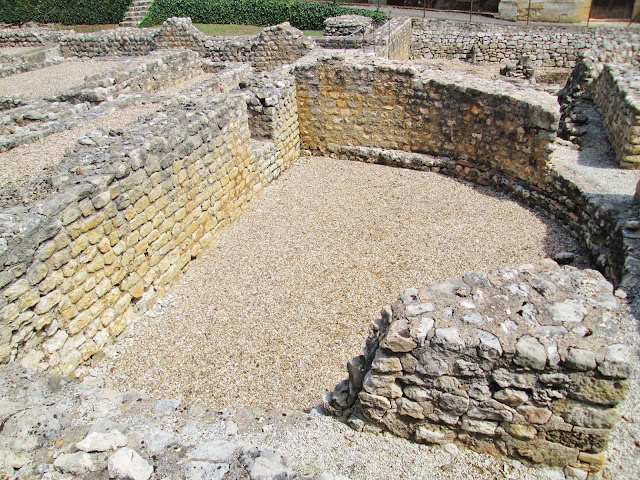 |
the church of St Pierre ès Liens - the tower on the left is 11th century
but the rest of the church destroyed and then rebuilt much later |
Spent a Sunday afternoon at a local
church, or more correctly, investigating the roman ruins on which this church
was built.
 |
| Adam and Eve |
 |
| St Peter and St Paul |
 |
| you can see the original roman walls beneath the church |
This extensive villa complex was started
in 1st century AD and inhabited until the 5th century.
 |
| old grave stone |
 |
| tranquil setting |
Benedictine monks came along in the 11th century and built a church
on the site using materials from the abandoned villa and some of the original
walls as foundations. There are even a few medieval burial sites in the walls
and floors of the old villa.
 |
| medieval burials |
Some of these medieval
burial plots were made almost directly onto the old Roman tile floors when it
was turned into a medieval cemetery. When more recent excavations were made
they found the tombs and remains sitting on the tiled floors as seen in the photo
below.
Because of this the church takes up a large space
in the centre of the complex so there is much of the roman ruins that cannot be
accessed. The church was partly destroyed during the wars of religion in the 16th
century ( this area was deeply protestant) and later rebuilt.
 |
| sea creatures |
 |
| now this is a bath ! |
 |
| shield design |
 |
| fishscale design |
 |
| knot design |
There are remains of cold and thermal
baths, colonnades, a gallery and the rooms of the villa itself. The mosaics are made of local limestone and
terracotta and use various motifs including fish, flowers, fish scales and
knots. The colours are not as bright as they would have been, but then they have been underground for fifteen hundred years. You can also see the watercourses built underneath the floors for
heating. The buildings are on a gentle slope facing south so I can imagine
the villa having views to the river Dordogne and across the valley.
 |
| the inside of the villa - those are two skeletons discovered buried in the mosaics |
 |
| magnificent mosaic floors |
 |
| underfloor drainage |
 |
| and yet more mosaic |
 |
| seems a shame to disturb his sleep |
A mosaic was first discovered during local building works in 1827. Then again in 1873 more objects were unearthed during more building activity. Pierre-Martial Tauziac, who collected finds from here as a child, later led the excavations in 1921 working with the Archaeological Society of Bordeaux. The site was listed as an historic monument in 1926.
Montcaret is only ten
minutes from our home, and roman ruins have also been found in Sainte Foy la
Grande. Unfortunately, most have been lost over the centuries, but it does show
that there has been a settlement of some sort here for at least two thousand
years.
 |
| roman ruins at Ste Foy have been relocated to a lovely terrace overlooking the river |
See, everyone who comes here
loves the Dordogne.
Très bonne semaine à tous mes amis
























No comments:
Post a Comment